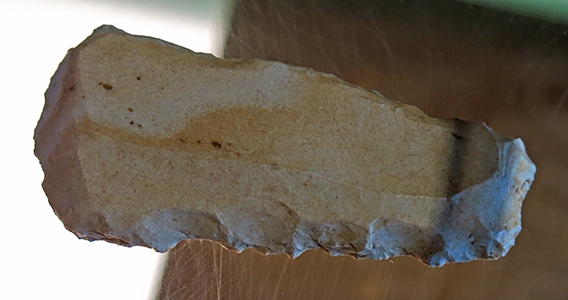Grottes du Pape, Brassempouy
Grottes du Pape, Brassempouy - The Venus of Brassempouy, or the lady with the hood was discovered in the Grottes du Pape, (Pope's Cave) in 1894, accompanied by at least eight other human figures. These may be an example of unfinished work, as if artist(s) carved several figurines at the same time. P.E. Dubalen first explored the Grotte du Pape in 1881, followed by J. de Laporterie and Édouard Piette (1827–1906) from 1894 onwards.Since archaeological excavation techniques were then only starting to develop, they paid little attention to the stratigraphy of the site containing the remains. In 1892 the site was pillaged and disturbed almost beyond reconstruction by a field trip of amateurs from the Association française pour l’avancement de la science.
Nevertheless, Piette described layers attributed to the late and middle Solutrean. He termed the bottom levels he reached as éburnéen (pale or white like ivory), in reference to the copious amounts of ivory works which they contained. Modern reanalysis of the site has been undertaken under the direction of Henri Delporte, 1981–2000.
In 1894, one of those strata, today recognized as Gravettian, yielded several fragments of female statuettes, including the 'Lady with the Hood'. Piette saw the figures as closely related to the representations of animals of the Magdalenian. He developed a hypothetical chronology that was later refuted by Henri Breuil.
Text above: Wikipedia

Recent Excavations at les Grottes du Pape, Brassempouy
Photo: http://brassempouy.pagesperso-orange.fr/grottes_026.htm
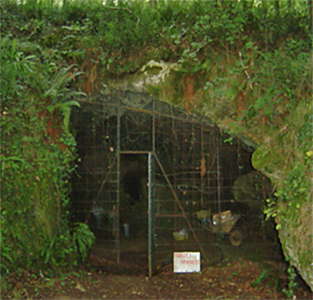
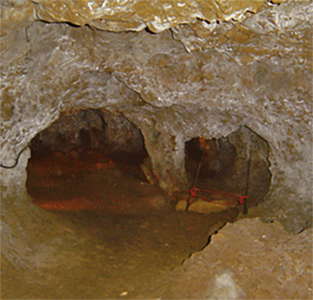
Entrance and interior of the Grottes du Pape.
Photo: http://fatrasenbleu.blog50.com/tag/brassempouy
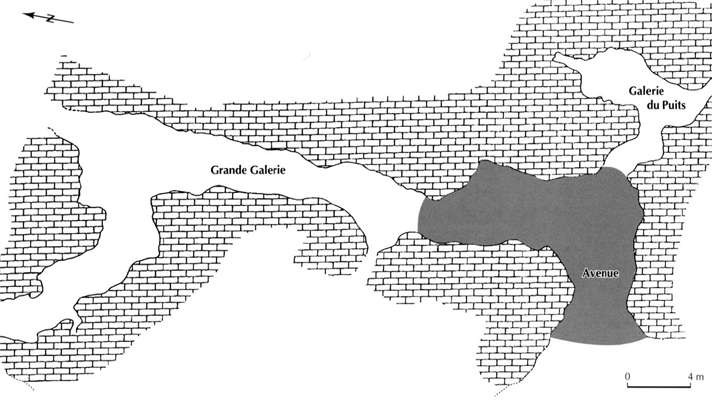
Plan of the Grottes du Pape.
Photo: Thiault (2001)
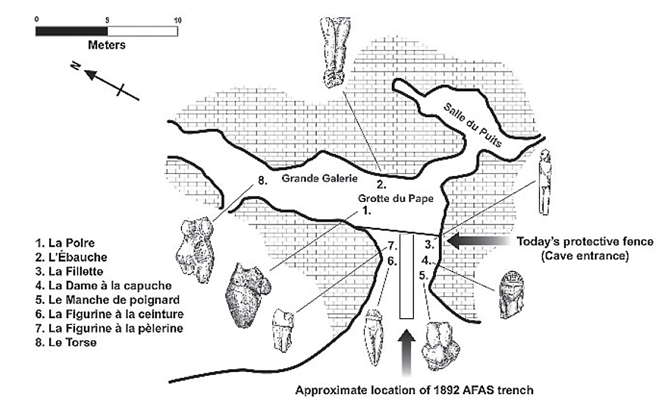
Plan of the Grottes du Pape showing where some of the finds were made.
Photo: Goutas et Simonet (2009)
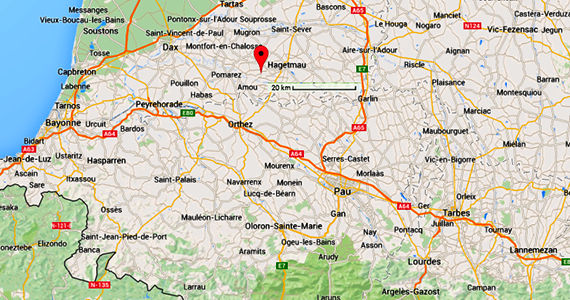
Location Map for Brassempouy
Photo: Google Maps
Les fouilles de Brassempouy en 1894

Édouard Piette (b. March 11, 1827, d. June 5, 1906) at about the time of his excavations at Brassempouy (Phototype Berthaud).
Source: White (2006)
The first exploratory works in the Quaternary gisement of Grottes du Pape, at Brassempouy, were made in 1880 by the Comte de Poudenx, owner of the deposit. Informed by M. du Moulin that during the enlargement of the access road to a quarry, workers had exposed the bones of extinct species, he deicided to make a search in the talus, and placed M. Dubalen in charge of the excavations. The removal of debris uncovered the entrance to a cave where, under a bed of silt, there were found archaeological layers containing simple engravings, engravings with edges shaped by carving, and sculptures in bas relief, objects encountered usually in Magdalenian sites. These layers were removed, but the formation in which they were situated was barely touched in some places, and there remained no clear notion of the nature and age.
Abandoned in 1881, excavations were resumed in 1890 by one of us, M. de Laporterie, assisted by Dr A. Leon Dufour. This led to the discovery of objects of ivory, including amulets and various sculptures, lying among the bones of wildlife of Mousterian appearance. Artworks in reindeer antlers were missing. Workers and artists therefore used ivory in their work as raw material before using reindeer antlers.
(According to Walton (2010) Piette objected to the use of the word Magdalénien, and proposed to replace it with the term Glyptique, saying that it was during this period that man learned to carve bones with flint. After the Solutré he placed the Éburnéenne, or ivory period, and after that the Tanandienne, characterised by instruments in reindeer horn - Don )
In 1892, l'Association française pour l'avancement des sciences, holding a conference at Pau wanted to take advantage of the proximity of Brassempouy to determine the nature of this deposit which seemed to prove the existence of a time ignored or imperfectly known. Unfortunately the search was poorly prepared, and when the sections of Geology and Anthropology arrived on the scene, the accumulation of debris on the outcrops had made all stratigraphic examination impossible. An important result came out of this exploration: this station contained human figures in ivory, valuable for the determination of quaternary races documents.
(this visit by the Association was a tragic disaster for archaeology. As White (2006) states:
Upon arrival on-site, each of the forty participants chose a sector and, with improvised tools or with picks and digging tools brought for the purpose, went to work with the implicit understanding that most discovered objects would remain the property of the finder. The preparatory work was badly done and the AFAS excursionists arrived to find the Solutrean exposures covered with backdirt, rendering any serious stratigraphic work impossible (Piette, 1895a, p. 134). When the excursionists went to work, no stratigraphic control was exercised. Although chaotic digging took place inside and outside the grotte du Pape, the excavations focused on a sagittal trench running outward from the cave opening, in what is generally known as 'l’Avenue' or sometimes 'l’Allée. In a brief note published shortly after the excursion, Cartailhac (1892) states that, once assembled on-site, de la Porterie and Dubalen provided a history of excavations to the members of the excursion. Soon after, they invaded the trenches. [ ] . . . everyone hastened to dig up the talus, working on his own behalf. They spoke little, each casting a furtive and jealous glance at their neighbor, who was suspected of having a better spot. The bags filled up.- Don )
We agreed together to make a serious study of what was left of the Brassempouy site. We began the execution of our project last spring. Despite a veritable downpour of excavation permit applications, all thrown into a basket as they were received, M. de Poudenx had reserved the task of exploring the final deposit to us. Favoured by beautiful weather, we commenced work at five in the morning, and left the site with the departure of our workers, and were able without interruptions to examine the stratigraphy of the deposits.
Before giving their superposition and nature, we must mention that M. Mascaraux came several times to help us in our research. It was he who found the smaller statues which we describe below.
(note that right and left are used throughout the description of the cave in the same sense as the true left and right of a stream - Don )
The site is located in a forest on the left bank of the Pouy stream, a tributary of the Luy de France. It consists of a cave for which the full ramifications are not yet explored and an avenue lined with steep low cliffs. The cave opens to the north-west, for an entry that has 6 metres 50 centimetres wide. The path by which one reaches it is 11 metres in length, it leads to a stream bordered by a farm road.
We began by removing all the debris accumulated by previous explorers, we widened the irregular trench dug by the workers of the Association française in the avenue, and we deepened it to bedrock. Then we could see what was left to explore. To the right in the cave, there was little to do, and it was there that had been found the most beautiful ivory pieces.
The rocky floor of the gallery extended and rose, and the archaeological layer became very thin. In the avenue, on the same side, some parcels of deposits belonging to the ivory industry still remained. They were composed of yellow earth mixed with rubble where we saw at unequal intervals ash hearths surrounded by hardened clay. We collected there, almost at the threshold of the cave, two statuettes: la figurine à la ceinture and la figurine à la pèlerine. We also found on that side, but further into the cave a carefully carved cylindrical ivory piece.
On the left side, a large strip of what still existed in the cave, where it had been stripped of the Magdalenian layers that had covered it, and it extended intact into the avenue under a thick layer of silt, without intermediate magdalénien. Outcrops of strata were very clear and very visible on the edge of the strip. We obtained the following sequence of layers:
10 cm - topsoil.
200 cm to 250 cm - yellow silt appearing to have been derived from loess.
90 cm - yellowish layer of earth, filled with limestone rubble, containing in its upper part, shouldered points, and throughout its thickness, the bones of mammoth, rhinoceros, spotted hyena, horse, deer, reindeer, etc.
This accumulation is more clayey, and darker in colour, it contains fewer stones, and we did not any find shouldered blades or laurel leaf points, but there was a fireplace surrounded by stones, similar to those that have been observed at Solutré. This hearth will be described later.
100 cm to 220cm - yellow clay, mixed with some limestone rubble, containing many Mousterian, Solutrean and Madeleine type flints. Solutrean flints are the most abundant. You do not see among them either shouldered blades or laurel leaf points. They are usually remarkable for their robustness and appear to have been shaped for working hard materials. They are thicker near the tip and may have two reinforcing keels, one above and the other below the blade.
Three weapons or tools seemed to have an unusual shape, notably a long point, flat and even on one side which was formed by the removal of a single flake, with the other multifaceted whose almost perpendicular to flat side is regularly cut long and wide retouches. Flints of Mousterian type are more numerous at the base of the formation than at its upper part. One can find amongst them large scrapers, but not the big almond shaped tools, knapped by large flakes on both sides, which could serve as coup-de-poing or hand axes.
At all depths, we collected bone and ivory awls, ivory points with beveled bases, and ivory blades similar to those which M. de Vibraye found at Laugerie basse with the figurine called Venus impudique. In the upper part of the layers, there were pierced canines of red deer and fox. We collected a large quantity of bones of horses, mammoths, rhinoceroses, spotted hyena, and less abundant fragments of aurochs, red deer, Canadian deer (white tailed deer? ), Reindeer , wolf, fox, badger, hare, rat, eagle, wood grouse, and (hazel? ) grouse.
Bones of reindeer were rare. They became a little more common in the upper part of the formation. In the lower part, to a height of thirty cm, the remains of mammoths and rhinos were lacking. The cave bear and the panther may perhaps be added to this list, since the workers of the French Association met with their debris, but we do not know if they came from the lower layers or that which contained the shouldered blades and the laurel leaf points.
When entering the trench, where we brought to light the outcrops of the successive layers, what looked especially striking was the presence of hearths at all heights, and the full extent of the ivory industry. At the top, near the entrance to the cave, there was a circle of stones of roughly equal size, contiguous and arranged evenly in a circle, recalling, by this construction, some of those hearths that have been observed in Solutré.
Its diameter was 140 cm, with ash 15 cm thick. It contained charred bones which were in unidentifiable splinters. Other hearths were varied in shape, but the most numerous were circular. They were coated on the bottom and sides with baked and hardened clay. Their diameter ranged from 60 cm to 50 cm and had a thickness of 10 cm to 80 cm. They were filled with black ash and many lumps of charcoal, remains of fires maintained with wood and meat waste.
We saw lots of bones, almost always unrecognisable, charred pieces of ivory, and sometimes half-burned mammoth and rhinoceros teeth. Almost all of these hearths were intact in the avenue, where they were separated by relatively large intervals. But on the left side of the cave, which was intensely occupied, they were touching, the inhabitants had destroyed the unused hearths in order to build more, and all the hearths were a heap of ashes and charcoal in which one could occasionally distinguish traces of clay walls. Everywhere objects had fallen into the fire and were destroyed. We found objects only in the gaps between the hearths, and they were better preserved when the soil in which they lay was less mixed with ash.
The existence of these hearths, often superimposed on each other, remaining intact in the avenue and sometimes especially on the right of the cave, shows that the site had suffered no damage since its formation. It is the result of prolonged habitation for many long years, during which the ground rose gradually by the accumulation of debris and human input. It should not be considered that the hearths of the avenue were the remains of fires lit at night to keep wild animals away. They are constructed in the same way as those of the cave. They were used to cook food; there were many abandoned broken tools. The inhabitants lived around the fires. The Eburnean climate was mild. The large amount of ash and debris of many mammoths show that the Eburnean climate was mild. The large amount of charcoal in the ash and the remains of many mammoths show that there were many forests. Man willingly stood outside the caves in his tent, at least during the summer. He lived in much better conditions than in Magdalenian times. The latter built their hearths differently.
They took a slab of sandstone, placed it horizontally, then placed other slabs of sandstone vertically around it. Often on the bare steppe surrounding the cave, they found dry grass to start the fire, at other times, they took branches of trees stunted by the cold, but they were saving wood, and they maintained the fire only with flesh. Charcoal is rare and is sometimes completely lacking in the black ash of Magdalenian sites.
Slabs of stone reddened by fire are quite abundant, but intact fireplaces are rare. The people, to avoid the pressing cold in the caves, destroyed the old fireplaces to make new ones. When the climate became wetter and milder, when the first the snow and then the abundant rains transformed everything around them, in the middle of forests which grew once more, they continued, by force of habit, to make fires from flesh and bone, right up until the neolithic epoch.

La Manche de poignard, or dagger handle, 27 000 BP
MAN47260
The size of this piece, 56 x 41 x 28 mm (according to http://www.photo.rmn.fr/cf/htm/CPicZ.aspx?E=2C6NU0XBUUXX, the dimensions in Piette et Laporterie (1894) appear to be in error) makes it more like a letter opener handle than the handle for a usable knife or dagger.
Photo: http://www.photo.rmn.fr/cf/htm/CPicZ.aspx?E=2C6NU0XBUUXX
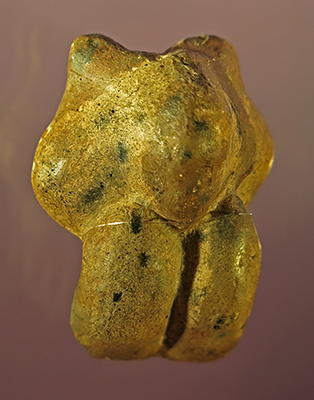
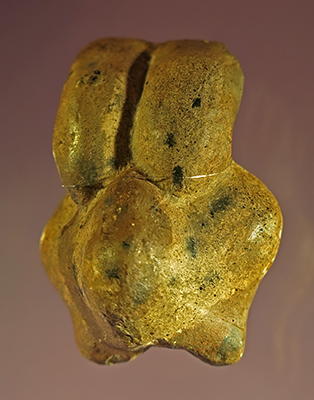
La Manche de poignard. Note that there appear to be two different orientations possible for the figurine from this side.
From the back, it is obvious (see image above) that the correct orientation is the one on the right in this pair of photos.
Photo: Don Hitchcock 2014
Source: Facsimile, la Maison de la Dame, Brassempouy Museum

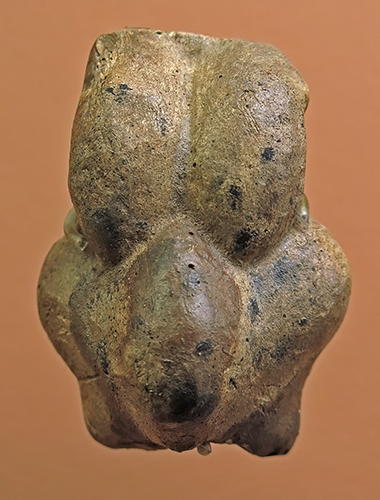
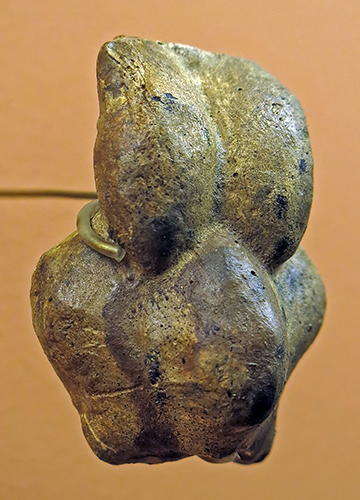
La Manche de poignard.
Photo: Don Hitchcock 2014
Source: Facsimile, Musée d'Archeologie Nationale et Domaine, St-Germain-en-Laye


La Manche de poignard. Note that the abdomen has lost some flakes of ivory, apparently recently judging from the drawing below by Piette et Laporterie (1894)
Photo: Don Hitchcock 2015
Source: Original, la salle Piette, Musée d'Archeologie Nationale et Domaine, St-Germain-en-Laye
Catalog: MAN47260
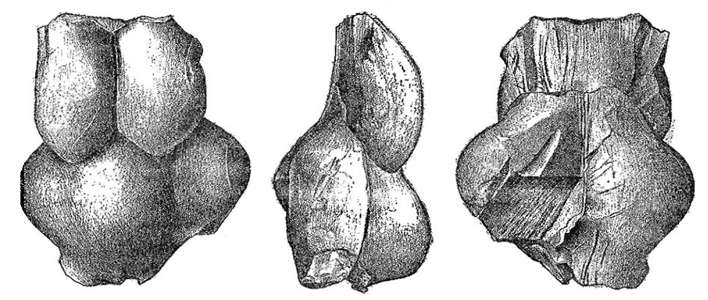
La Manche de poignard, 56 mm long. This is a smaller piece than most venus figures.
Piette et Laporterie (1894) describe this as a dagger handle, with the blade of the knife arising from the back. What follows is the description from the authors.
Photo: Piette et Laporterie (1894)
The piece is 20 mm wide and 4 mm thick. (this seems to be a typo. 14 mm? - Don ) The breasts are cylindrical and pendant, the belly is large and hanging. The depression of the spine in the middle of the back is well shown.
Huge protuberances of fat cover the hips and descend a little lower than the place where the buttocks should arise. These are completely lacking. The obligation of the artist was to make a convenient handle for a knife, and was forced to sacrifice the truth of some aspects of the sculpture. Thus the torso, as a result of the transition of the back to the blade, lacks thickness, and the buttocks have been suppressed. A woman with this physical makeup would have been very uncomfortable in a seated position. The sculpture is true to the shape of the breasts, the development of the stomach and the lumps of fat on the hips.
The large figurine found by the workers of the French association is 'longinymphe' (having extended labia).
(Note that this description has been derided as being a racial slur based on the physical characteristics of the 'Hottentot' bushmen, a topic which was then in the news in France, and has been seen as making the figurine seem to be 'primitive' and 'other', see
Lander (2005) - Don )
The upper abdomen is carinate or ridged, the thighs are very thick, bulging in the front like those of the Hottentots. The breasts and belly of the figurine are very similar to the statuette of Mas d'Azil.
Text: Piette et Laporterie (1894)
Translation: Don Hitchcock
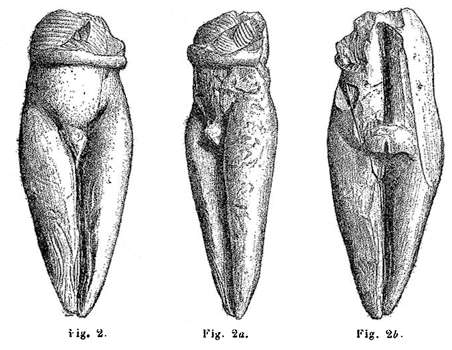
La figurine à la Ceinture - The figurine with a belt
MAN47077, 68 mm
This figurine is of the lower part of a human body. It is difficult to determine the sex. The belly is as flat as that of a man. The hips and thighs have female contours. The legs are pressed one against the other, and end in points.
Photo and text: Piette et Laporterie (1894)
Translation: Don Hitchcock
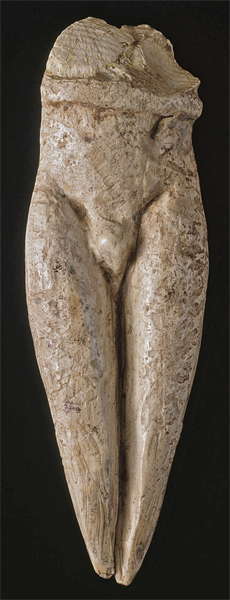
The sexual organs are not shown distinctly, and this suggests that they are not those of a man, for artists of all time, even those of Greece and our own sculptors represent man with all the attributes of manhood, and they would not have thought differently at a time when all went naked, and where feelings of shame would not be very well developed.
People who have viewed this statuette generally consider it to be that of a woman whose Mount of Venus is very prominent and placed very low. The sexual organs of women are not visible when standing. The artist, by omitting them, would be consistent with reality. This figurine never had feet. The vertical groove in the back is deep.
Photo: © RMN / Jean-Gilles Berizzi
Source: http://www.panoramadelart.com/dame-de-brassempouy
Text: Piette et Laporterie (1894)
Translation: Don Hitchcock
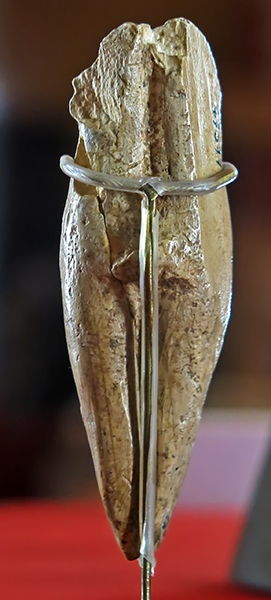
La figurine à la Ceinture - The figurine with a belt, rear view.
Note that the 'belt' does not continue across the back of the figurine.
Photo: Don Hitchcock 2015
Source: Original, la salle Piette, Musée d'Archeologie Nationale et Domaine, St-Germain-en-Laye

The buttocks are only separated from each other by a small line, and are of a smallness not found in nature. It would seem that the artist who sculpted the statuette sought to move away from the convention of fat women for these statues.
A belt encircles the sides of the figure, but there is no skirt.
Photo: © RMN / Jean-Gilles Berizzi
Source: http://www.frru2.altervista.org/ARCH/VEP/PAL/Grav/gaEF.htm
Text: Piette et Laporterie (1894)
Translation: Don Hitchcock
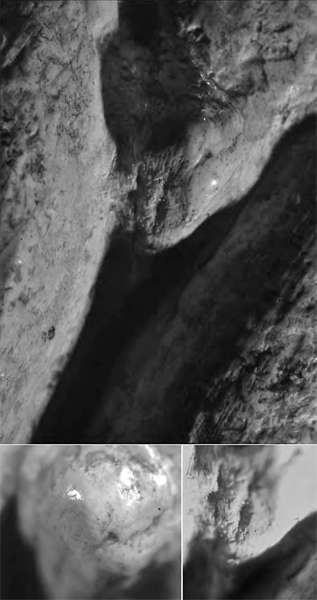
The highly polished mons venus of the Figurine à la ceinture viewed from above and to the right. The impression of an out-of-focus vaginal slit is confirmed by higher magnification in image at right (18×). This is quite strong evidence in favour of a female attribution of this figurine.
Photo and text: White (2006)
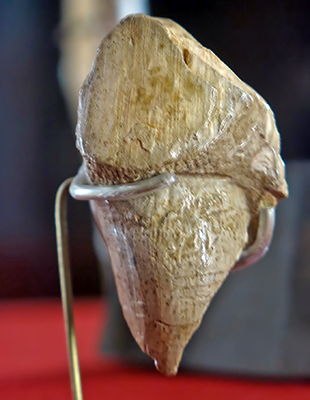
This venus figurine fragment from Brassempouy is identified as figure 8 by Piette.
He says of it:
'A quite shapeless fragment, in which we think we see the attachment of a broken-off shoulder, part of a breast and falling hair. This interpretation is only half satisfactory.'
Photo: Don Hitchcock 2015
Source: Original, la salle Piette, Musée d'Archeologie Nationale et Domaine, St-Germain-en-Laye

These are other views of the fragment.
The photograph above corresponds most closely to view 8a.
Photo: Piette (1907)
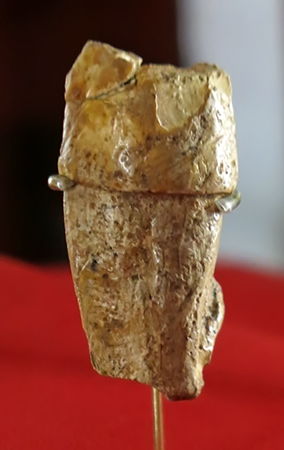
Figurine à la pèlerine - Figurine dressed in a cape. Circa 25 000 BP.
Height 46 mm, width 23 mm, depth 11 mm.
Photo: Don Hitchcock 2015
Source: Original, ivory, la salle Piette, Musée d'Archeologie Nationale et Domaine, St-Germain-en-Laye
Catalog: MAN47136
Text: https://www.photo.rmn.fr
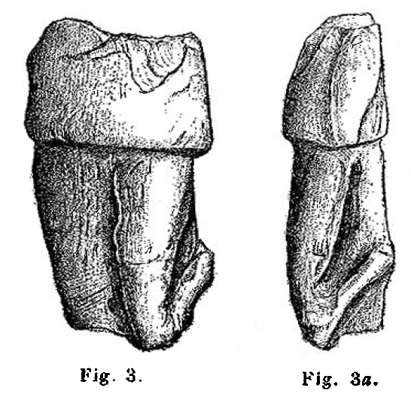
Figurine à la pèlerine - Figurine dressed in a cape.
Fragment of the torso of a figure wearing a cape. The arm in bas relief is folded across the chest. Sculptors had recognised how fragile arms are when they are detached from the trunk, and they used bas relief to represent them. The arm tapers in thickness from the shoulder to the elbow.
Photo and text: Piette et Laporterie (1894)
Translation: Don Hitchcock


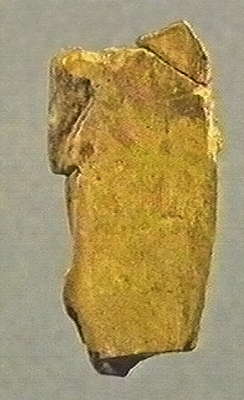
Figurine à la pèlerine - Figurine dressed in a cape.
Height 46 mm, width 23 mm, thickness 11 mm.
Photo: http://www.culture.gouv.fr/
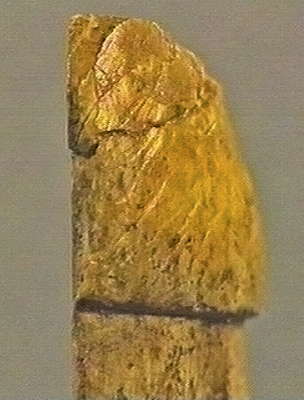

Figurine à la pèlerine - Figurine dressed in a cape.
Photo: http://www.culture.gouv.fr/
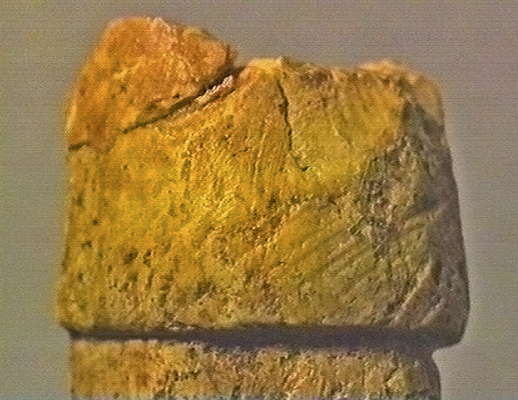
Figurine à la pèlerine - Figurine dressed in a cape.
Photo: http://www.culture.gouv.fr/

Figurine à la pèlerine - Figurine dressed in a cape.
Photo: http://www.culture.gouv.fr/

Figurine à la pèlerine - Figurine dressed in a cape.
Photo: White (2006)
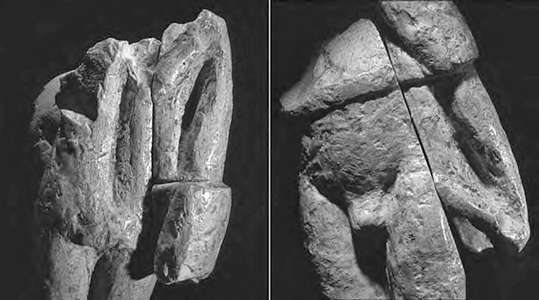
In this photograph we may see the strange refitting of the Figurine à la pèlerine and the Figurine à la ceinture. At right, the slight gap results either from a very thin, missing lamina or from subtle chemical solution.
Within the Brassempouy sample of ivory, virtually all the pieces were broken during fabrication. This further implies
that the sculptor(s)was working with partially dessicated tusks, where the collagen binding the lamina together had been compromised. In fresh tusks, these laminar interfaces are not points of weakness.
The first of these is embodied in the re-fitting of two of the figurines (the Figurine à la pèlerine and the Figurine à la ceinture), previously considered by most researchers to be independent objects. However, Breuil had astutely seen that their forms were such that the two might conjoin if we had the missing intervening fragments. It is not clear whether he ever tried to refit them as is; an opportunity that was given to me by the curators at Saint Germain-en-Laye. The result was stunning.
The two figurines, found together in the avenue share a common fracture surface along a laminar interface, although there may be a very thin lamina missing. They re-fit nicely, even if the margins of the fracture surface are slightly smoothed by very subtle chemical solution. However, when re-fitted, the result makes no morphological sense . . . even if certain surface structures (the belt for example) mesh very cleanly, one with the other.
For me, there is only one solution to this enigma. The sculptor began to sculpt a figurine out of partly dessicated ivory. This first figurine was quite far along when it broke into at least two pieces along a laminar boundary. Each fragment was subsequently reappropriated, each to be sculpted in its own right. The fact that the fracture surface remained intact may suggest that one or both of the 'new' supports was abandoned before completion. In the case of the Figurine à la pèlerine the portion above the 'belt' was apparently carried away by a subsequent (but prehistoric) transverse fracture.
Photo and text: White (2006)
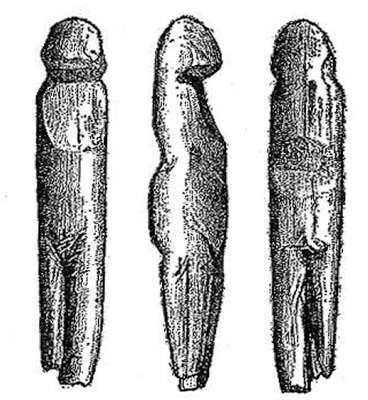
La fillette; La poupée
Figurine of a girl, made with just a few blows of the flint. It is a child's toy. She has no arms, and probably never had feet. She is naked, and her hair is long. The sex is shown.
Photo and text: Piette et Laporterie (1894)

Another view of La fillette, La poupée.
Photo: Don Hitchcock 2014
Source: Facsimile, Musée d'Archeologie Nationale et Domaine, St-Germain-en-Laye
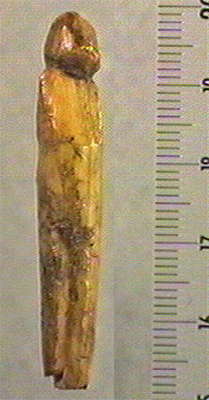
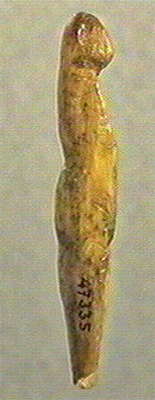

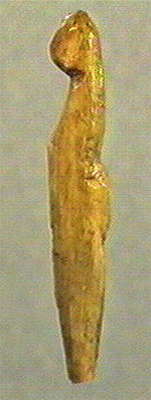
La fillette; La poupée
The statuette was collected on the left side of the Avenue, near the entrance to the grotte.
A small female statuette, carved to a long, narrow shape, the thin body is reminiscent of a young girl. It has a small head, the face and hair is not carved.
Photo and text: http://www.culture.gouv.fr/

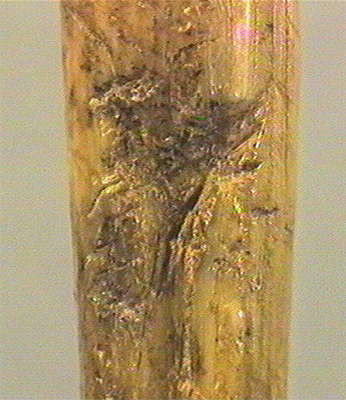
La fillette; La poupée
The torso is fractured, the belly is flat, a pubic triangle is shown, as well as a back, buttocks, and marked waist.
The legs are thin and fractured. Delporte thinks that the breasts may have disintegrated, but Piette thought it was a child's toy.
48 mm high, 8 mm wide, 7.5 mm thick.
Photo and text: http://www.culture.gouv.fr/
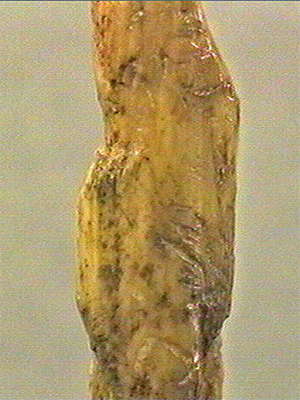
La fillette; La poupée
Photo and text: http://www.culture.gouv.fr/

Three views of the ivory figurine that Piette named La Fillette (the young girl).
It was found by Piette’s collaborator Mascaraux during the 1894 excavations.
Photo and text: White (2006)
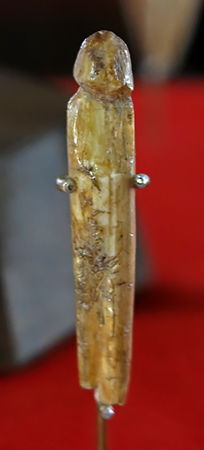
La Fillette.
Photo: Don Hitchcock 2015
Source: Original, la salle Piette, Musée d'Archeologie Nationale et Domaine, St-Germain-en-Laye
Catalog: MAN47335

A view of the Ébauche de Poupee, a rough draft of a doll.
Photo: Don Hitchcock 2014
Source: Facsimile, Musée d'Archeologie Nationale et Domaine, St-Germain-en-Laye
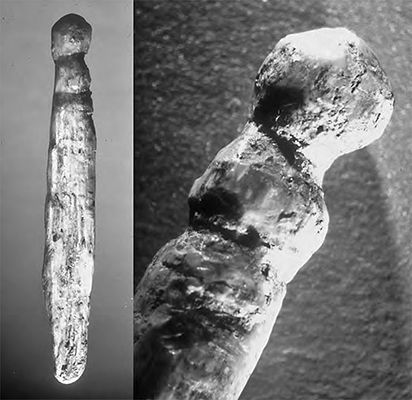
Macro and micro views of the Ébauche de Poupée, showing significant tool traces that, if the piece is interpreted as an anthropomorphic figure, define the head, chest and abdomen (Photo, R.
White).
Photo: White 2006
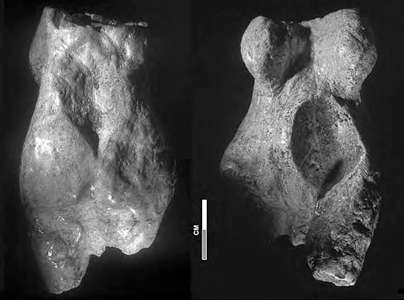
Two views of the figurine known as Le Torse, discovered during the 1896 excavations in the frontal portion of the Grande Galérie.
Photo and text: White (2006)
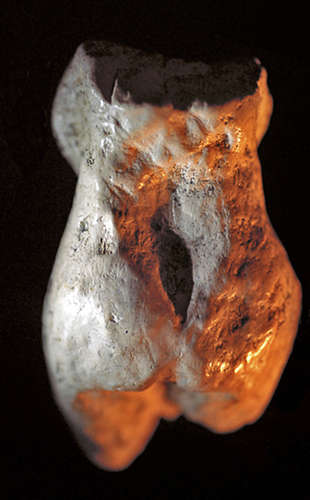
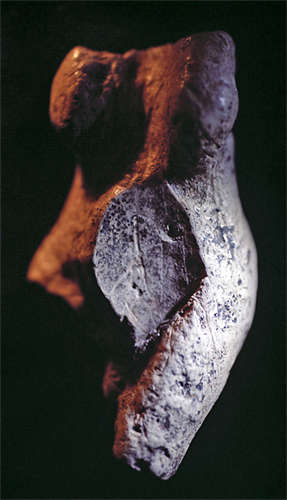
Le Torse, original.
(note that these photos have been altered from the original superb works of art by Claire Artemyz.
Here is the original on the left,
and here is the original on the right - Don )
Photo: © Claire Artemyz, http://www.bradshawfoundation.com/memoires/index.php

Facsimile of le Torse.
Photo: Don Hitchcock 2014
Source: La Maison de la Dame, Brassempouy Museum
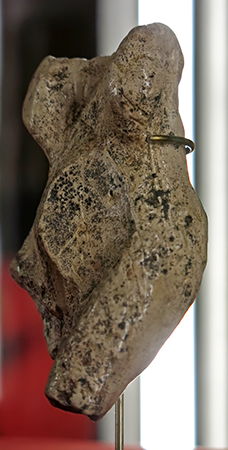
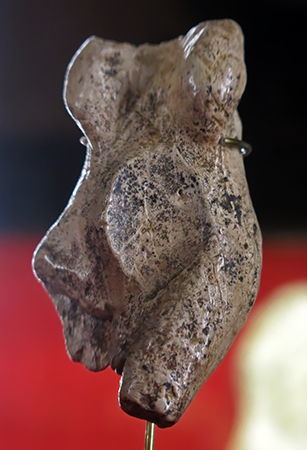
Le Torse, 3/4 and frontal view.
Height 94 mm, width 52 mm, depth 48 mm.
Photo: Don Hitchcock 2015
Catalog: MAN47334
Source: Original, la salle Piette, Musée d'Archeologie Nationale et Domaine, St-Germain-en-Laye
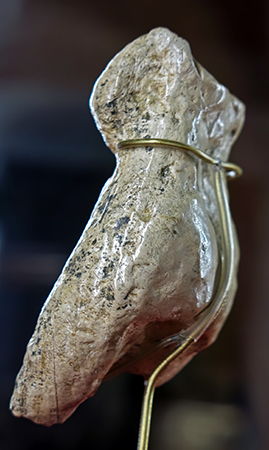
Le Torse.
The venus from behind.
It is more realistic, with more natural proportions than many other venus figures.
Photo: Don Hitchcock 2015
Source: Original, la salle Piette, Musée d'Archeologie Nationale et Domaine, St-Germain-en-Laye

Profile and top views of Le Torse (the torso), showing the internal structure of the mammoth ivory.
Photo and text: White (2006)
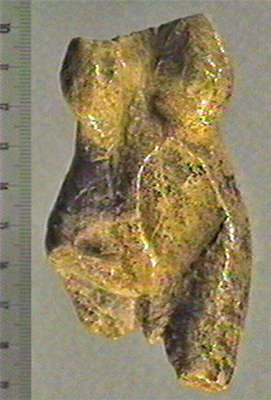
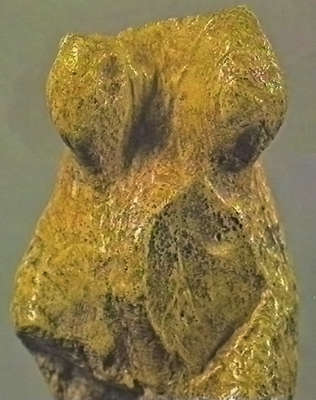
The Torso
A flake of ivory has broken off in ancient times, leaving a flat surface on the abdomen.
This Gravettian figurine was found during the 1896 excavations by Édouard Piette and J. de Laporterie. It was found in the upper part of the figurines layer, 4 or 5 cm above a fireplace.
Dimensions: 94 mm high, 51.5 mm wide, 48 mm thick.
Conserved at: Saint-Germain-en-Laye, National Museum of Archaeology, 47334; APM02121
Photo and text: http://www.culture.gouv.fr/

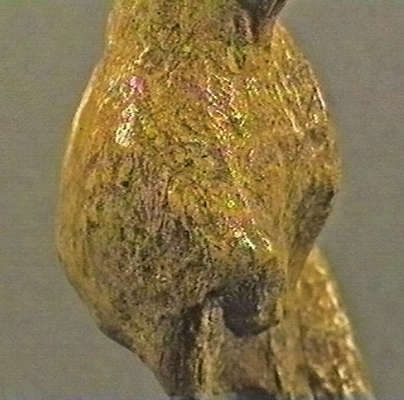
The Torso
View from the right, showing the flexed position of the figurine, with the legs, one of which is a stub, projecting forwards, as though the figure was half-sitting.
Photo: http://www.culture.gouv.fr/
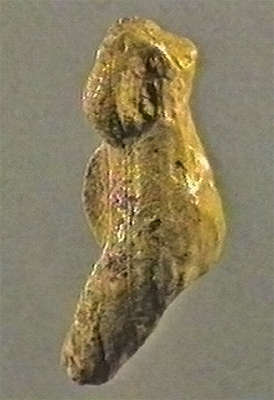
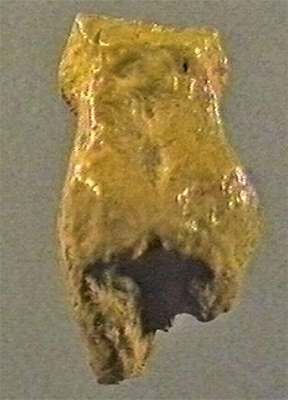
The Torso
View from the left and the rear.
Photo: http://www.culture.gouv.fr/

The figurine fragment known as l'Ébauche, (the rough-out), found during the AFAS excursion of September 19, 1892 (Photo, R. White).
Photo and text: White (2006)


The figurine fragment known as l'Ébauche, (the rough-out) was found during the AFAS excursion of September 19, 1892.
Piette says: This is the lower part of an unfinished male statuette. We can still see the marks of the burin. The feet are unfinished. The legs and thighs are those of a man and have nothing reminiscent of a woman's hips. This is probably the bottom of a pendant.
Photo: Don Hitchcock 2015
Source: Original, La Salle Piette, Musée d'Archeologie Nationale et Domaine, St-Germain-en-Laye
Text: Piette (1907)
Catalog: MAN47022

The platform or mastaba at La Maison de la Dame, Brassempouy Museum.
It features larger than life size sculptures of three of the most well known of the venus figures from Brassempouy.
352 Rue du Musée, 40330 Brassempouy, France, Phone: +33 5 58 89 21 73
Photo: Don Hitchcock 2014
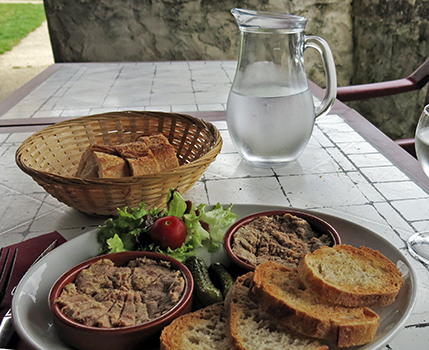
There is a restaurant associated with the museum, serving good meals.
Photo: Don Hitchcock 2014
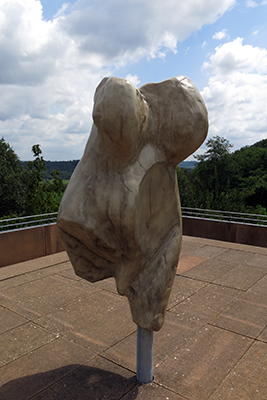
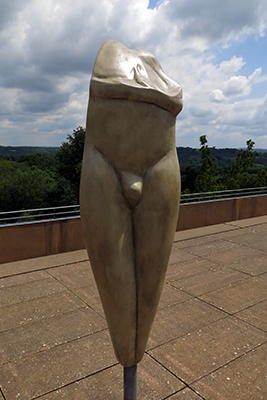

The Torso, La figurine à la Ceinture - the figurine with a belt, and the Venus of Brassempouy, the most famous of all the Brassempouy venus figures.
The sculptures are on a raised platform known as a mastaba. Architects were Peter and Eric Raffy, and the sculptor of all three figures was Roseline Conil.
Photo: Don Hitchcock 2014
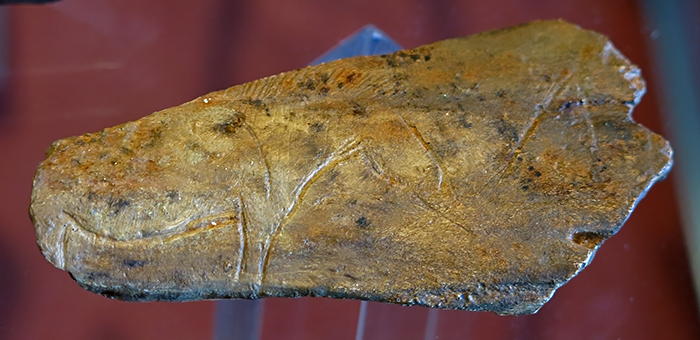
Engraving in bone representing the forequarters of a horse.
Magdalenian, excavations of E. Piette and J. de Laporterie, grotte du Pape.
Photo: Don Hitchcock 2014
Provenance: Facsimile of the original, kept at MAN
Source and text: La Maison de la Dame, Brassempouy Museum
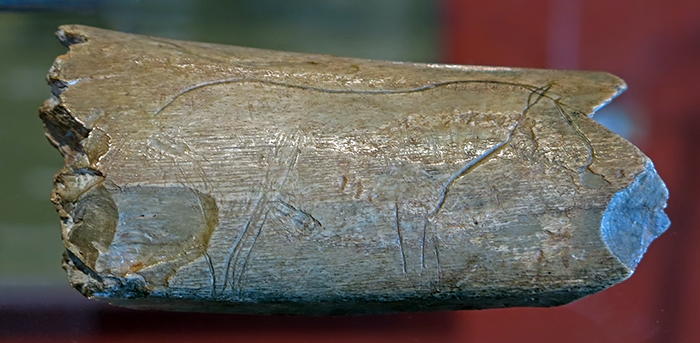
Engraving in bone representing two horses.
Magdalenian, grotte du Pape.
(presumably there is another horse on the other side of this piece - Don )
Photo: Don Hitchcock 2014
Provenance: Facsimile, excavations of P.-E. Dubalen, grotte du Pape
Source and text: La Maison de la Dame, Brassempouy Museum

Engraving in bone representing the belly and hindquarters of an animal, probably a horse.
Magdalenian, grotte du Pape.
Photo: Don Hitchcock 2014
Provenance: Facsimile, excavations of P.-E. Dubalen, grotte du Pape
Source and text: La Maison de la Dame, Brassempouy Museum
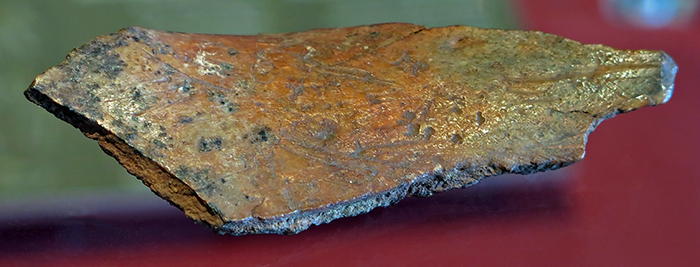
Engraving in bone, of an unknown subject.
Magdalenian, grotte du Pape.
Photo: Don Hitchcock 2014
Provenance: Facsimile, excavations of P.-E. Dubalen, grotte du Pape
Source and text: La Maison de la Dame, Brassempouy Museum
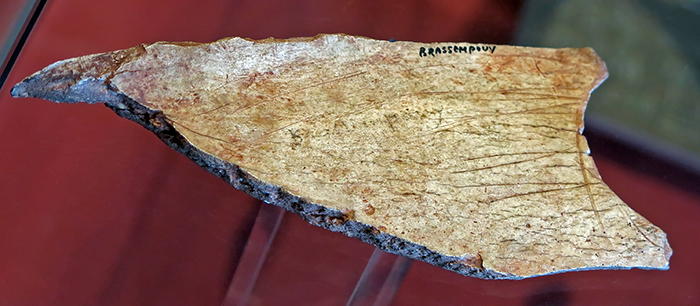
Fragment of a scapula from which a 'rondelle' has been cut.
Magdalenian, grotte du Pape.
Photo: Don Hitchcock 2014
Provenance: Facsimile, excavations of P.-E. Dubalen, grotte du Pape
Source and text: La Maison de la Dame, Brassempouy Museum
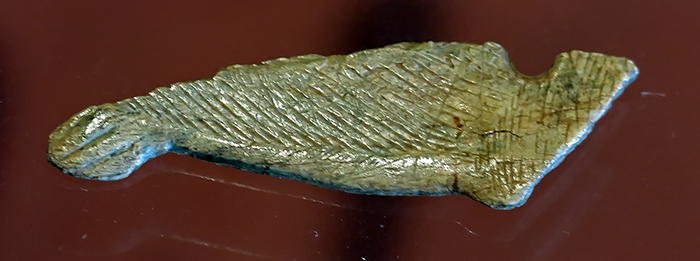
Fragment of contour découpé in bone representing a seal (?).
(this appears to have had a hole bored in it for use as a pendant - Don )
Photo: Don Hitchcock 2014
Provenance: Facsimile, excavations of P.-E. Dubalen, grotte du Pape
Source and text: La Maison de la Dame, Brassempouy Museum

Fragment of contour découpé in bone representing a fish (?)
Magdalenian
Photo: Don Hitchcock 2014
Provenance: grotte du Pape, excavations of H. Delporte
Source and text: La Maison de la Dame, Brassempouy Museum

Fragment of deer antler decorated with geometric motifs.
Photo: Don Hitchcock 2014
Provenance: Facsimile, excavations of P.-E. Dubalen, grotte du Pape
Source and text: La Maison de la Dame, Brassempouy Museum

Fragment of bone decorated with geometric motifs.
Photo: Don Hitchcock 2014
Provenance: Facsimile, excavations of P.-E. Dubalen, grotte du Pape
Source and text: La Maison de la Dame, Brassempouy Museum

(above) Fragment of bone with incisions.
(below) Fragment of the bone of a bird with incisions.
Photo: Don Hitchcock 2014
Provenance: Facsimile, excavations of P.-E. Dubalen, grotte du Pape
Source and text: La Maison de la Dame, Brassempouy Museum

Fragment of the bone of a bird with incisions.
Photo: Don Hitchcock 2014
Provenance: Facsimile, excavations of P.-E. Dubalen, grotte du Pape
Source and text: La Maison de la Dame, Brassempouy Museum

Fragment of perforated deer antler decorated with geometric designs.
Photo: Don Hitchcock 2014
Provenance: Facsimile, excavations of P.-E. Dubalen, grotte du Pape
Source and text: La Maison de la Dame, Brassempouy Museum
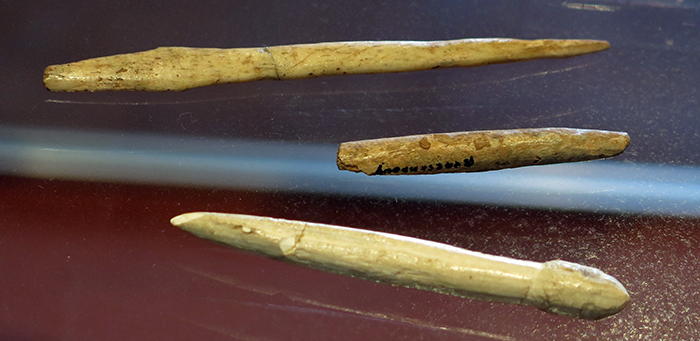
From top to bottom:
Fragment of pointed bone.
Pointed object made of deer antler.
Object made of ivory (?)
Photo: Don Hitchcock 2014
Provenance: Facsimile, excavations of P.-E. Dubalen, grotte du Pape
Source and text: La Maison de la Dame, Brassempouy Museum
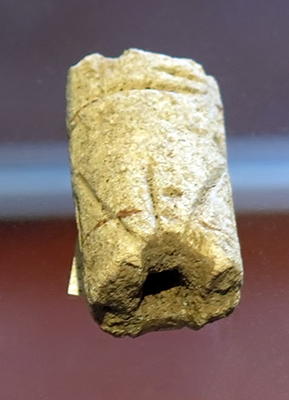
Section of perforated deer antler decorated with geometric designs.
(note the three incisions which are very like the representation of a vulva - Don )
Photo: Don Hitchcock 2014
Provenance: Facsimile, excavations of P.-E. Dubalen, grotte du Pape
Source and text: La Maison de la Dame, Brassempouy Museum
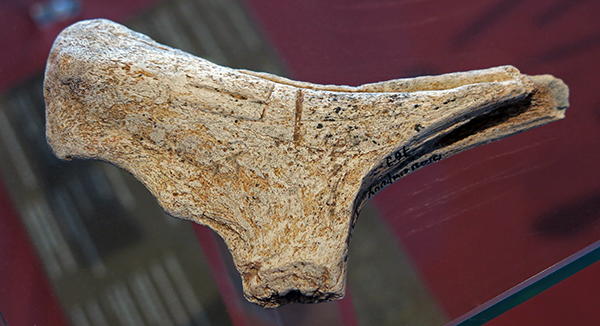
Piece of deer antler discarded after the extraction of the useful sections.
Photo: Don Hitchcock 2014
Provenance: Facsimile, excavations of P.-E. Dubalen, grotte du Pape
Source and text: La Maison de la Dame, Brassempouy Museum

Piece of deer antler discarded after the extraction of the useful sections.
Photo: Don Hitchcock 2014
Provenance: Facsimile, excavations of P.-E. Dubalen, grotte du Pape
Source and text: La Maison de la Dame, Brassempouy Museum

Piece of deer antler discarded after the extraction of the useful sections.
Photo: Don Hitchcock 2014
Provenance: Facsimile, excavations of P.-E. Dubalen, grotte du Pape
Source and text: La Maison de la Dame, Brassempouy Museum

Piece of ivory decorated with geometric designs.
Photo: Don Hitchcock 2014
Provenance: Facsimile, excavations of P.-E. Dubalen, grotte du Pape
Source and text: La Maison de la Dame, Brassempouy Museum

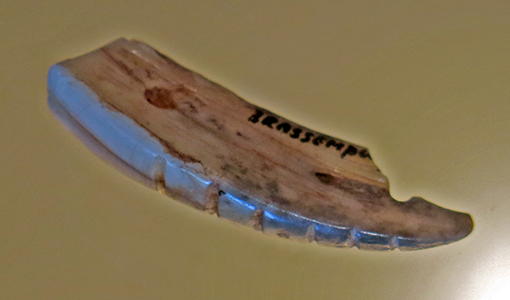
Incisors of horses engraved and perforated.
Photo: Don Hitchcock 2014
Provenance: Brassempouy, excavations of P.-E. Dubalen
Collection: Musée Dubalen, Mont-de-Marsan, Landes
Source and text: La Maison de la Dame, Brassempouy Museum

(left) Perforated deer canine, Brassempouy, grotte de Pape, excavations of H. Delporte.
(right) Perforated deer canine, probably Magdalénien, Sorde-l'Abbeye, Landes, collection P.-E. Dubalen.
Photo: Don Hitchcock 2014
Source and text: La Maison de la Dame, Brassempouy Museum

Perforated herbivore incisor.
Photo: Don Hitchcock 2014
Provenance: Brassempouy, excavations of P.-E. Dubalen
Collection: Musée Dubalen, Mont-de-Marsan, Landes
Source and text: La Maison de la Dame, Brassempouy Museum

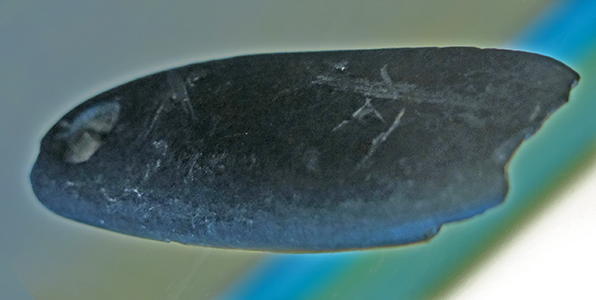
Perforated pebble of schist(?)
Photo: Don Hitchcock 2014
Provenance: Brassempouy, excavations of P.-E. Dubalen
Source and text: La Maison de la Dame, Brassempouy Museum

Perforated herbivore incisor.
Photo: Don Hitchcock 2014
Provenance: Brassempouy, excavations of P.-E. Dubalen
Collection: Musée Dubalen, Mont-de-Marsan, Landes
Source and text: La Maison de la Dame, Brassempouy Museum

Perforated wolf incisor.
Photo: Don Hitchcock 2014
Provenance: Brassempouy, excavations of P.-E. Dubalen
Collection: Musée Dubalen, Mont-de-Marsan, Landes
Source and text: La Maison de la Dame, Brassempouy Museum
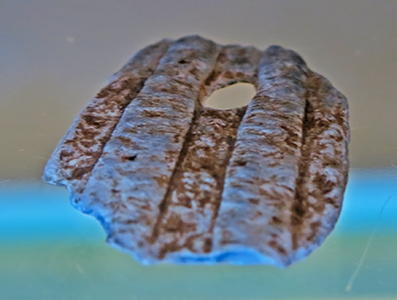
Perforated fragment of a pecten shell.
Photo: Don Hitchcock 2014
Provenance: Brassempouy, excavations of P.-E. Dubalen
Collection: Musée Dubalen, Mont-de-Marsan, Landes
Source and text: La Maison de la Dame, Brassempouy Museum

Fragment of polished bone carrying incisions, a decorated lissoir or polisher/stretcher (of hides).
Photo: Don Hitchcock 2014
Provenance: Brassempouy, excavations of P.-E. Dubalen
Collection: Musée Dubalen, Mont-de-Marsan, Landes
Source and text: La Maison de la Dame, Brassempouy Museum
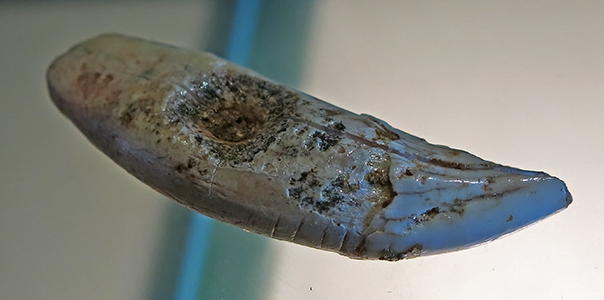
Engraved and perforated lion's canine tooth.
Photo: Don Hitchcock 2014
Provenance: Grottes des Hyènes, Brassempouy, excavations of H. Delporte
Source and text: La Maison de la Dame, Brassempouy Museum
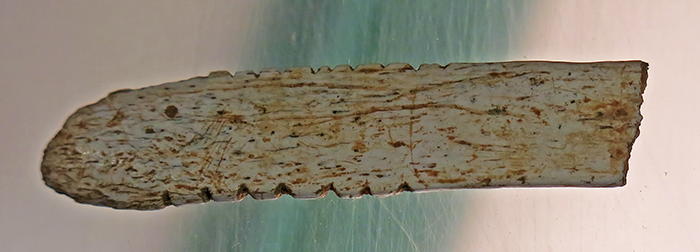
Fragment of polished bone carrying incisions, a decorated lissoir or polisher/stretcher (of hides).
Photo: Don Hitchcock 2014
Provenance: Grottes des Hyènes, Brassempouy, excavations of H. Delporte
Source and text: La Maison de la Dame, Brassempouy Museum
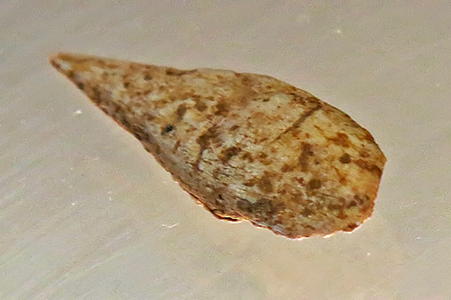
Spear point with forked base, made of deer antler.
Photo: Don Hitchcock 2014
Provenance: Brassempouy, excavations of P.-E. Dubalen
Source and text: La Maison de la Dame, Brassempouy Museum
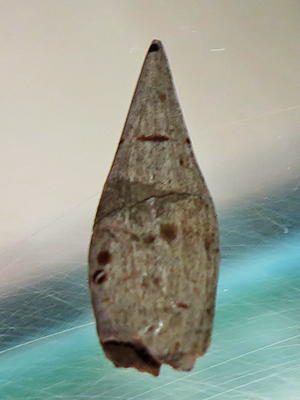
Spear point with forked base, made of deer antler.
Photo: Don Hitchcock 2014
Provenance: Grottes des Hyènes, Brassempouy, excavations of H. Delporte
Source and text: La Maison de la Dame, Brassempouy Museum

Aurignacian blade.
Photo: Don Hitchcock 2014
Provenance: Grottes des Hyènes, Brassempouy, sector 59, excavations of D. Gambier
Source and text: La Maison de la Dame, Brassempouy Museum
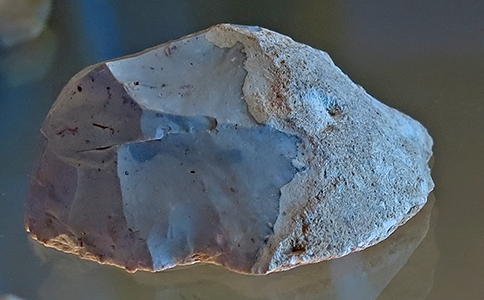
Grattoir caréné (keeled scraper, from a core used to make blades)
Photo: Don Hitchcock 2014
Provenance: Grottes des Hyènes, Brassempouy, excavations of H. Delporte
Source and text: La Maison de la Dame, Brassempouy Museum
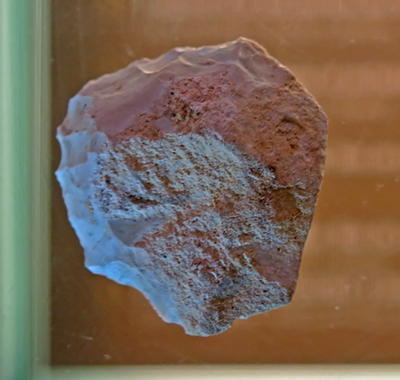
Thick grattoir (scraper) made on a flake.
Photo: Don Hitchcock 2014
Provenance: Grottes des Hyènes, Brassempouy, excavations of H. Delporte
Source and text: La Maison de la Dame, Brassempouy Museum
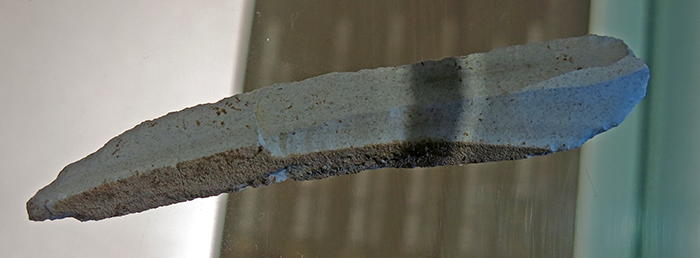
Retouched blade, two photographs of the same object.
The dark band in the second photograph and some of those below is a shadow from the case above.
Photo: Don Hitchcock 2014
Provenance: Grottes des Hyènes, Brassempouy, excavations of H. Delporte and D. Gambier
Source and text: La Maison de la Dame, Brassempouy Museum

Retouched blade.
Photo: Don Hitchcock 2014
Provenance: Grottes des Hyènes, Brassempouy, excavations of H. Delporte and D. Gambier
Source and text: La Maison de la Dame, Brassempouy Museum
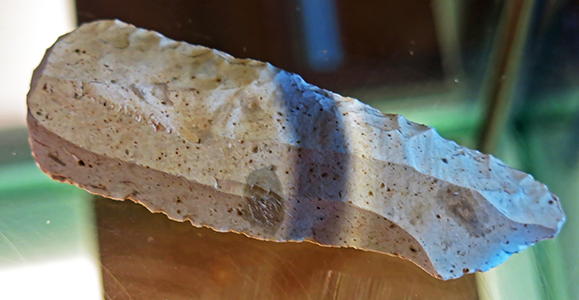
Grattoirs on retouched blades.
Photo: Don Hitchcock 2014
Provenance: Grottes des Hyènes, Brassempouy, excavations of H. Delporte and D. Gambier
Source and text: La Maison de la Dame, Brassempouy Museum
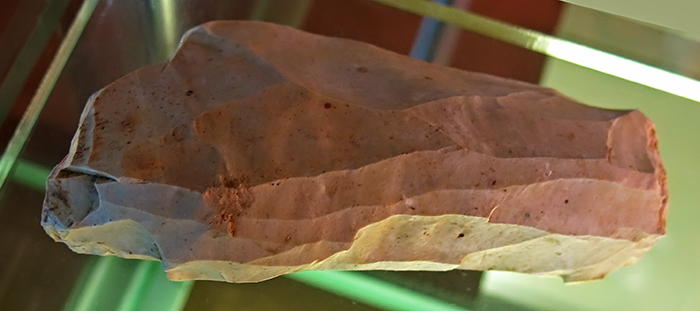
Core from which blades have been struck.
Photo: Don Hitchcock 2014
Provenance: In front of the grotte de Pape, Brassempouy, sector Ch1, excavations of H. Delporte
Source and text: La Maison de la Dame, Brassempouy Museum

Blade as it came from the core, unretouched.
Photo: Don Hitchcock 2014
Provenance: In front of the grotte de Pape, sector Ch1, Brassempouy, excavations of H. Delporte
Source and text: La Maison de la Dame, Brassempouy Museum
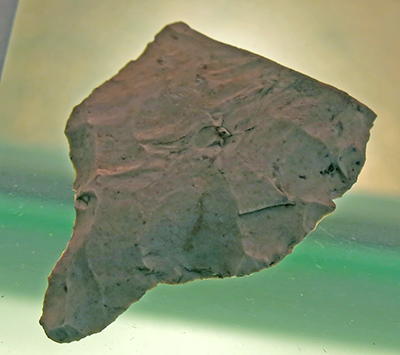
Stalked piece.
Photo: Don Hitchcock 2014
Provenance: sector Ch1, Brassempouy, excavations of H. Delporte
Source and text: La Maison de la Dame, Brassempouy Museum

Laurel leaf point.
Photo: Don Hitchcock 2014
Provenance: Brassempouy, excavations of P.-E. Dubalen
Source and text: La Maison de la Dame, Brassempouy Museum
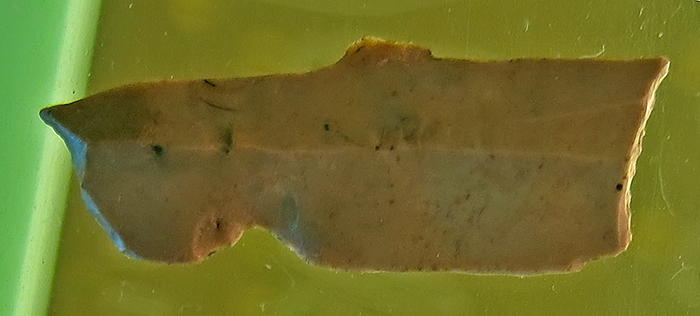
Burin de Noaille, Gravettian.
Photo: Don Hitchcock 2014
Provenance: In front of the grotte de Pape, sector Ch1, excavations of H. Delporte
Source and text: La Maison de la Dame, Brassempouy Museum

Burin de Noaille, Gravettian.
Photo: Don Hitchcock 2014
Provenance: In front of the grotte de Pape, sector Ch1, excavations of H. Delporte
Source and text: La Maison de la Dame, Brassempouy Museum
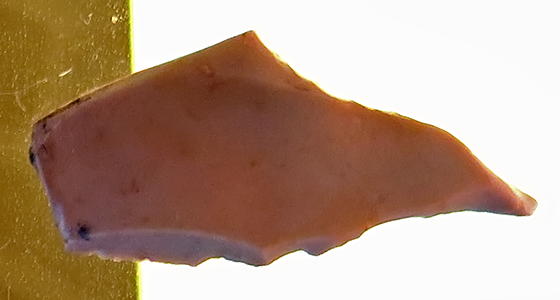
Perçoir (awl), Gravettian.
Photo: Don Hitchcock 2014
Provenance: In front of the grotte de Pape, sector Ch1, excavations of H. Delporte
Source and text: La Maison de la Dame, Brassempouy Museum
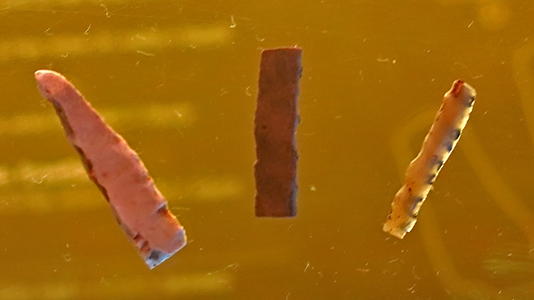
Backed blades.
Photo: Don Hitchcock 2014
Provenance: In front of the grotte de Pape, sector Ch1, excavations of H. Delporte
Source and text: La Maison de la Dame, Brassempouy Museum

From left to right:
1. Spear head with a simple bevel.
2. Grooved spear head with a simple bevel.
3. Fragment of a spear head, made of deer antler. (From the excavations of H. Delporte).
4. Fragment of a grooved spear head.
5. Fragment of an ivory point.
6. Spear head with a double bevel decorated with geometric designs.
Photo: Don Hitchcock 2014
Provenance: Facsimile, excavations of P.-E. Dubalen, grotte du Pape unless otherwise noted
Source and text: La Maison de la Dame, Brassempouy Museum

Fragments of spear heads with forked bases, made of deer antler - Magdalenian.
Photo: Don Hitchcock 2014
Provenance: Facsimile, excavations of P.-E. Dubalen, grotte du Pape
Source and text: La Maison de la Dame, Brassempouy Museum
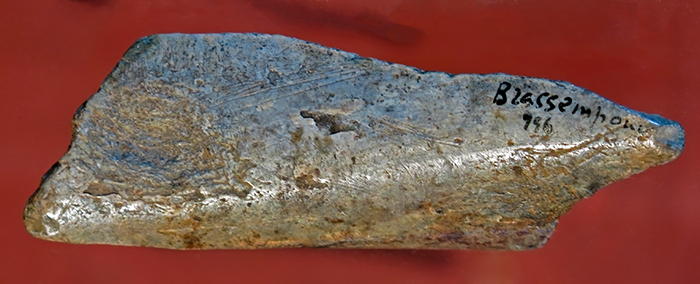
Engraved bone, with indeterminate motifs.
Probably Magdalenian.
Photo: Don Hitchcock 2014
Provenance: Facsimile, excavations of P.-E. Dubalen, grotte du Pape
Source and text: La Maison de la Dame, Brassempouy Museum
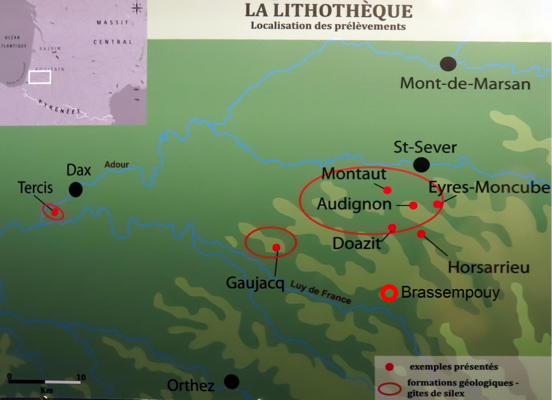
The area from which the flint below was sourced. Red dots indicate the examples shown, and the ellipses identify the sources from which the flint was obtained.
Photo: Don Hitchcock 2014
Source and text: La Maison de la Dame, Brassempouy Museum
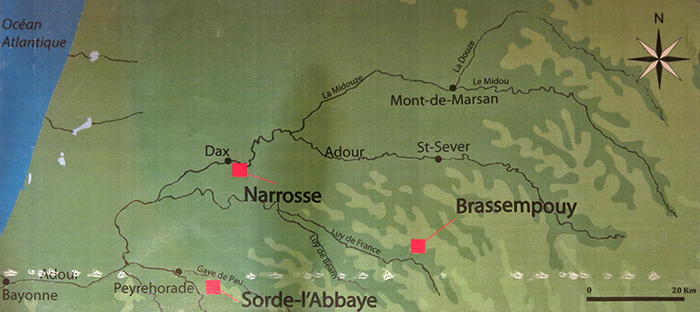
Map of the region.
Photo: Don Hitchcock 2014
Source and text: La Maison de la Dame, Brassempouy Museum
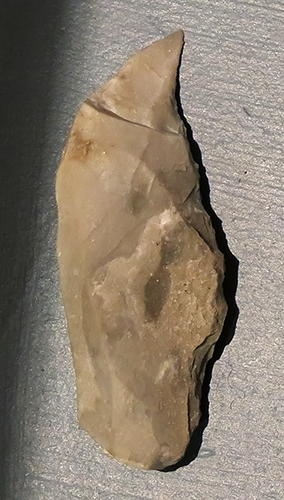
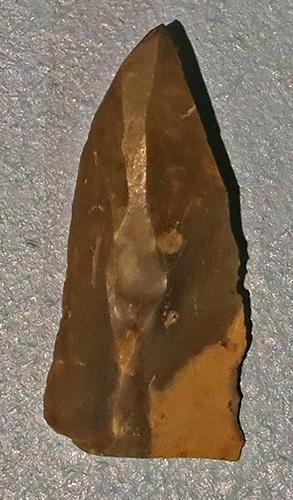
(left) Perçoir (reproduction)
Reconstitution and experimental material - M. Baillet
(right) Dihedral burin, used to groove and sculpt.
Brassempouy, upper Palaeolithic.
Photo: Don Hitchcock 2014
Provenance: Brassempouy, Collection Delmas - Maison de la Dame
Source and text: La Maison de la Dame, Brassempouy Museum
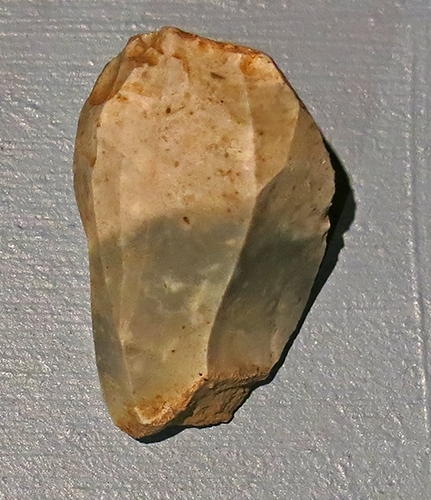
Blades nucleus (core, block of quartz shaped in a manner to provide, with repeated blows, a maximum of blades).
Brassempouy, upper Palaeolithic.
Photo: Don Hitchcock 2014
Provenance: Brassempouy, Collection Delmas - Maison de la Dame
Source and text: La Maison de la Dame, Brassempouy Museum
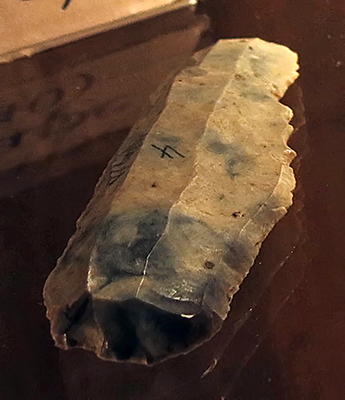
Grattoir (scraper) on a blade.
Flint from the anticline of Audignon.
Brassempouy
Photo: Don Hitchcock 2014
Provenance: Brassempouy, Collection of P.-E. Dubalen, Upper Paleolithic
Source and text: La Maison de la Dame, Brassempouy Museum

Blade.
Flint from the anticline of Audignon.
Brassempouy
Photo: Don Hitchcock 2014
Provenance: Brassempouy, Collection of P.-E. Dubalen, Upper Paleolithic
Source and text: La Maison de la Dame, Brassempouy Museum

Point
Flint from the anticline of Audignon.
Brassempouy
Photo: Don Hitchcock 2014
Provenance: Brassempouy, Collection of P.-E. Dubalen, Upper Paleolithic
Source and text: La Maison de la Dame, Brassempouy Museum
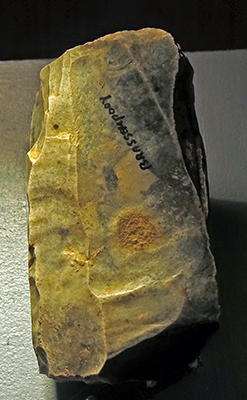
Nucleus or core.
Flint from the anticline of Audignon.
Brassempouy
Photo: Don Hitchcock 2014
Provenance: Brassempouy, Collection of P.-E. Dubalen, Upper Paleolithic
Source and text: La Maison de la Dame, Brassempouy Museum
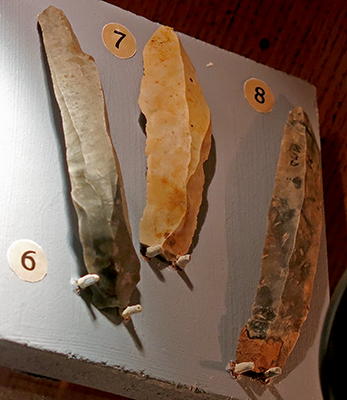
Unretouched blades
Flint from the anticline of Audignon.
Photo: Don Hitchcock 2014
Provenance: Brassempouy, Collection H. Delporte
Source and text: La Maison de la Dame, Brassempouy Museum

This is an ivory waterbag stopper from Brassempouy.
(this appears to be a museum quality facsimile - Don )
Photo: http://paleobox.forumactif.com/t2049p40-sortie-paleobox-le-29-septembre-au-man
Source: Display at Musée d'Archéologie nationale, Saint-Germain-en-Laye
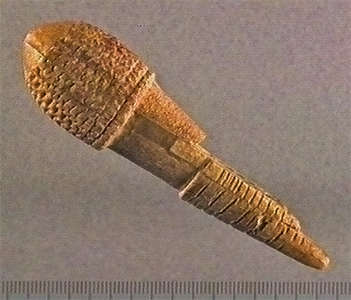
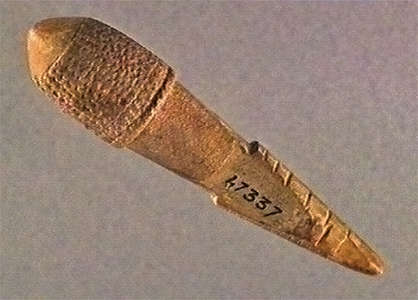
This is the ivory waterbag stopper from Brassempouy.
(this appears to be the original - Don )
Photo: © Saint-Germain-en-Laye, musée des antiquités nationales, © Direction des musées de France, 2002
Source: http://www.culture.gouv.fr/

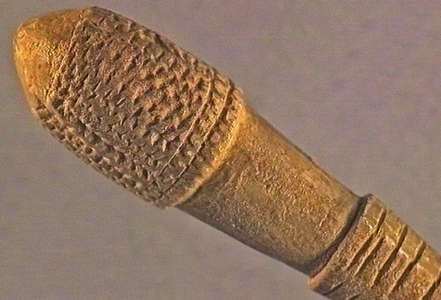
Aurignacian, deeply carved. The upper part of the object is smooth and rounded. It is followed by a cylindrical band fully decorated with rows of serpentine patterns.
The centre of the object is a wide band forming a constriction. The lower tapering part is decorated several rows of transverse incisions.
Photo: © Saint-Germain-en-Laye, musée des antiquités nationales, © Direction des musées de France, 2002
Source: http://www.culture.gouv.fr/
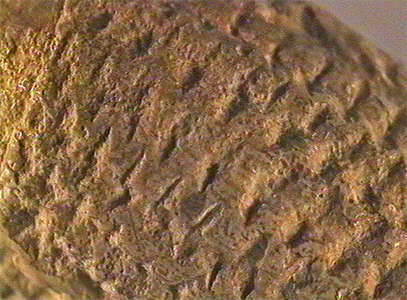
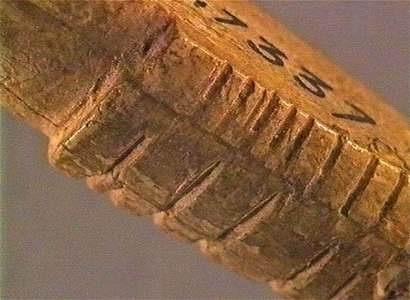
Length 91 mm, maximum diameter 25 mm
Photo: © Saint-Germain-en-Laye, musée des antiquités nationales, © Direction des musées de France, 2002
Source: http://www.culture.gouv.fr/
A recent summary of excavations and the occupation of the site from Henry-Gambier et al. (2004) :
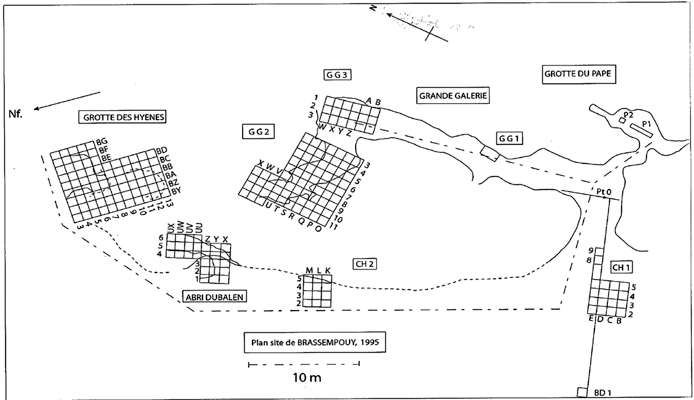
Excavations by H. Delporte, D. Buisson 1981-1995
Photo: R. Mensan, Henry-Gambier et al. (2004)
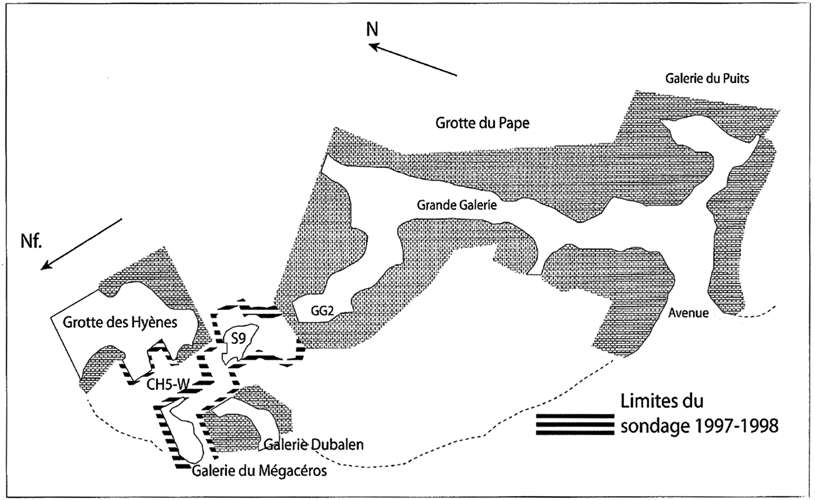
1997-1998 site plan
Photo: R. Mensan, Henry-Gambier et al. (2004)
- The Châtelperronian occupations (37-34 000 BP) are only preserved in the pits formed in the karst (gallery Dubalen in particular), and the stratigraphic transition between Châtelperronian and Aurignacian (in the broad sense) is poorly understood, the proto-Aurignacian occupations existing only in the Dubalen gallery. Aurignacian deposits are only truly preserved in the northern part of the site.
- Some lithic evidence of an upper Aurignacian (31 000 to 29 000 years BP), found in Ensemble 1 of la grotte des Hyènes, reflect either the timely arrival of the last groups of Aurignacian or the occurrence of important habitats on the slopes or beyond, in areas of the cave network that we have no knowledge of.
- The interval 29 000 - 25 000 BP is the most 'black' period in terms of sedimentary record and / or retention of deposits. The grotte des Hyènes is completely filled in, and the grotte du Pape gives no evidence of the presence or absence of the men of Brassempouy.
- Between 25 000 and 15 000 BP, if we exclude any outdoor occupations, only the entrance and around the edges of the grotte du Pape seems to have been occupied. Data from previous excavations in this area and those of recent excavations at Site 1 suggests a good conservation of traces of the Gravettian occupations, including Noailles burins, and the middle/upper Solutrean. According to information available, the absence of the highest Gravettian or lower Solutrean deposits appears to be directly attributable to taphonomic phenomena that totally truncated traces of their occurrence. The same applies to subsequent Solutrean groups Solutré (Badegoulian 1, Lower Magdalenian), during which the site seems not to have been occupied.
References
- Cartailhac, E., 1892: Station préhistorique de Brassempouy (Landes), La Nature, 20: 298–299.
- Goutas, N., Simonet A., 2009: Le secteur GG2 de la grotte du Pape à Brassempouy (Landes) : un dépôt intentionnel d’armes gravettiennes ?, Bulletin de la Société préhistorique française, 2009, tome 106, No 2, p. 257-291
- Henry-Gambier, D. et al., 2004: Nouvelles données sur la séquence culturelle du site de Brassempouy (Landes): Fouilles , Archéologie des Pyrénées Occidentales et des Landes, Tome 23,2004
- Lander, L., 2005: From artifact to icon: an analysis of the Venus figurines in archaeological literature and contemporary culture, Durham theses, Durham University. Available at Durham E-Theses Online: http://etheses.dur.ac.uk/3027/
- Piette, E., Laporterie J., 1894: Les fouilles de Brassempouy en 1894, Bulletins de la Société d'anthropologie de Paris, IV° Série, tome 5, 1894. pp. 633-648.
- Piette, E., 1907: L'art pendant l'Age du renne, Paris : Masson, 1907, 112 p., 128 fig., 99 pl.
- Thiault, M., 2001: L'exploitation et la transformation de l'ivoire de mammouth : une étude technologique d'objets gravettiens de la grotte du Pape (Brassempouy, Landes), Gallia préhistoire, Tome 43, 2001. pp. 153-174.
- Walton, W., 2010: Paris From The Earliest Period To The Present Day, Volume, FQ Books (July 6, 2010)
- White, R., 2006: The Women of Brassempouy: A Century of Research and Interpretation, Journal of Archaeological Method and Theory, Vol. 13, No. 4, December 2006
Back to Don's Maps
 Back to Archaeological Sites
Back to Archaeological Sites
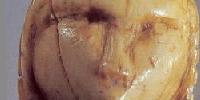 Brassempouy Venus - this miniature head, 36.5 mm high, 22 mm deep and 19 mm wide, was carved from mammoth ivory. Found at Brassempouy, Landes, France in 1892. It may be 25 000 years old. It is one of the few Ice Age figures with facial features and a detailed hairstyle. It is the original for the 'Ayla' head from Jean Auel's Earth Children series of books. Some doubt its authenticity, since it was recovered at a dig where the workers were paid by what they discovered.
Brassempouy Venus - this miniature head, 36.5 mm high, 22 mm deep and 19 mm wide, was carved from mammoth ivory. Found at Brassempouy, Landes, France in 1892. It may be 25 000 years old. It is one of the few Ice Age figures with facial features and a detailed hairstyle. It is the original for the 'Ayla' head from Jean Auel's Earth Children series of books. Some doubt its authenticity, since it was recovered at a dig where the workers were paid by what they discovered.
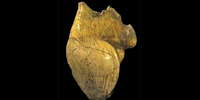 La Poire is a figurine of mammoth ivory of which only the corpulent torso survives, found in 1892 in the 'Grotte du Pape' at Brassempouy. The name 'Venus' for this figurine was subsequently adopted by Édouard Piette (1827-1906). She was originally nicknamed la poire - 'the pear' - on account of her shape. For Piette, the name 'Venus' may have come to mind in this particular instance because of the emphatic treatment of the vulva's labia and the prominent, slightly protruding pubic area, which he tastefully refers to as 'le mont de Vénus' - the mound of Venus (or mons pubis). 'Venus' has since become the collective term used to identify all obese Palaeolithic statuettes of women.
La Poire is a figurine of mammoth ivory of which only the corpulent torso survives, found in 1892 in the 'Grotte du Pape' at Brassempouy. The name 'Venus' for this figurine was subsequently adopted by Édouard Piette (1827-1906). She was originally nicknamed la poire - 'the pear' - on account of her shape. For Piette, the name 'Venus' may have come to mind in this particular instance because of the emphatic treatment of the vulva's labia and the prominent, slightly protruding pubic area, which he tastefully refers to as 'le mont de Vénus' - the mound of Venus (or mons pubis). 'Venus' has since become the collective term used to identify all obese Palaeolithic statuettes of women.

